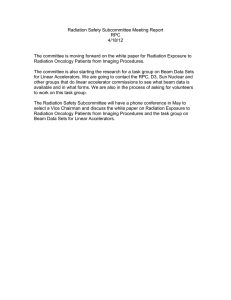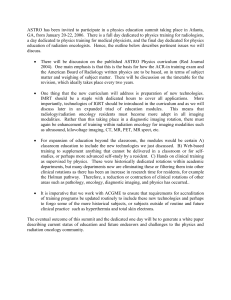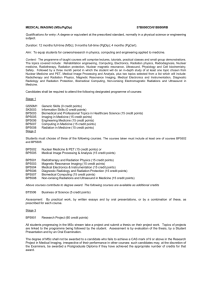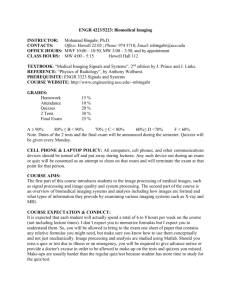Radiation Risk Communications and Conversations: Providing Care or Promoting Scare?
advertisement
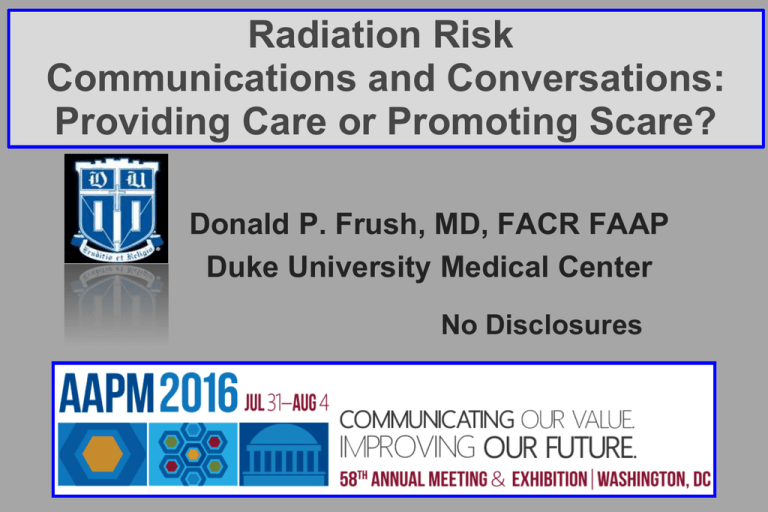
Radiation Risk Communications and Conversations: Providing Care or Promoting Scare? Donald P. Frush, MD, FACR FAAP Duke University Medical Center No Disclosures • No risk discussion, but… • Landscape – What is said – What is heard • Messaging • No risk discussion, but… • Landscape – What is said – What is heard • Messaging Facts • • • • Radiation in diagnostic imaging is a “hot” topic Public and caregivers remain concerned There is mis-information The “harm and alarm” voice is loud 4 “We value virtue but do not discuss it. The honest bookkeeper, the faithful wife [or husband], the earnest scholar get little of our attention compared to the embezzler, the tramp, the cheat.” Page 164 John Steinbeck 1961 Radiologist: “As many as 1 in 300 children who get a CT scan of the abdomen, chest or spine will eventually develop a tumor as a result of the radiation...” http://www.huffingtonpost.com/entry/childrens-hospitals-ctscans-study_55df8791e4b0c818f6175b69 And, from USA accreditation authority in 2016 “…consensus opinion that … there is harm at low doses” 7 Consumer Reports: Surprising Dangers of CT Scans and Xrays ... "that about one-third of those scans serve little if any medical purpose" No Risk Risk www.sportsgamesrules.com Journal of American Physicians and Surgeons Volume 13 Number 1 Spring 2008 “Risk of ALL was elevated in children exposed to three or more post natal xrays…” Lancet June 2012 First direct assc of CT and cancer Increased risk of leukemia and brain tumors with childhood CT “1 additional brain tumor per 10,000 childhood brain CTs” Although… BJC: “This study suggests that the indication for examinations, whether suspected cancer or [predisposing factors] management, should be considered to avoid overestimation of the cancer risks associated with CT scans.” Recently… 15 Content is important… • Image Gently • Image Wisely • RadiologyInfo.org Canada Safe Imaging Image Gently Image Wisely EuroSafe Japan Safe AfroSafe LatinSafe Global validation of need for communication and education 17 Tenets: Should Remember • Imaging (CT) is beneficial • • • Professionalism: patient autonomy We have responsibility to inform Content is important Tenets: Should Remember • Imaging (CT) is beneficial • • • • Patient rights We have responsibility to inform Content is important Delivery is equally important - when, who, how Legalplanet.wordpress.com Medical (Imaging) Environment • • • • • • • Potential lack of control (helplessness) Unfamiliarity Decisions for others High anxiety Sense of urgency Potential consequences Limited access Need for Communication CONCLUSION. Despite growing concerns regarding medical radiation exposure, there is still limited awareness of radiationinduced cancer risks among patients and physicians. There is also no consensus regarding who should provide patients with relevant information, as well as in what specific situations and exactly what information should be communicated. Radiologists [the imaging team] should prioritize development of consensus statements and novel educational initiatives with regard to radiationinduced cancer risk awareness and communication. Need for Communication Risk Communication • Uncertainty is a challenge to discuss • Patient/caregiver perspectives are challenges • Low probability generally overemphasized What do parents hear when you say “1 in 2,000 risk of cancer” 1 in 2,000 = “my child” AND 1999 others • No risk discussion, but… • Landscape – What is said – What is heard • Messaging Risk Communication • Uncertainty is a challenge to discuss • Patient/caregiver perspectives are challenges • Low probability generally overemphasized • Relative risks: many ways to frame - CXRs, other radiation, other life events, days lost • Keep it (simple) direct, anticipate divergence Communication Skills Effective Communication • Informativeness: quantity and quality of health information provided by the physician; • Interpersonal sensitivity: affective behaviors that reflect the doctor’s attention to, and interest in, the parents’ and child’s feelings and concerns; • Partnership building: the extent to which the physician invites the parents (and child) to state their concerns, perspectives, and suggestions during the consultation. PEDIATRICS Volume 121, Number 5, May 2008 Risk Communication “Truly informed medical decision-making that respects patient autonomy requires appropriate framing of radiation risks in perspective with other risks and with the benefits of imaging. To follow the principles of personalized medicine and treat patients according to their specific phenotypic and personality profiles, diagnostic imaging should optimally be tailored not only to patient size, body region and clinical indication, but also to underlying disease conditions, radio-sensitivity and risk perception and preferences that vary among individuals.” Pediatric Radiology 44; 2014 Risk Communication Fletcher et al. Perspective on Radiation Risk in CT imaging. Abdominal Imaging 2012 Broder and Frush April 2016 Message Mapping • • • • • Tool for public health risk communication. Messages few in number (e.g., 3) Brief i.e., 9-10 words Language clear: 8th grade Layered, hierarchically organized: - anticipate the questions and concerns - organize in response to those questions and concerns - develop key messages and supporting information WHO Communicating Radiation Risk in Pediatric Imaging 2016 Your child may have a significant brain injury… so we need to do a CT scan ____________________________________ • Question: “I heard that CT scans can cause cancer. Will my son get cancer? • Answer: “Possibly.” • Question: “What is the radiation for the CT?” • Answer: “Relatively high; I don’t know exactly.” • Question: “How do you do CT scans in children?” • Answer: “I don’t know.” …confidence? • Question: “How much medical radiation has he had?” • Answer: “I don’t know.” What Should You Say? 1. That is a good question 2. I can answer that 3. We have (hopefully) expertise - know the doses - minimize radiation 4. This is a necessary/important exam - I avoid “numbers” 5. Other questions? May 2016, 24 yr old professional: “I don’t know how to use a house phone” AJR 204, 2015: W48-W51 One recommendation was for more active engagement by radiologists on Twitter What About Consent? 2-2-11 Duke/UNC Survey: 34 Emergency Medicine MDs • “Signed, informed consent for CT?” – 27 (79%) – 6 (18%) – 1 ( 3%) : No : No opinion : Yes, but then apologized for not understanding original question … so, 0% wanted this consent WHO Radiation Risk Communication in Paediatric Imaging Informal Survey September 20th, 2010 • • • • • • • • • • • • • • Patient/Parent Advocates Radiologists Medical Physicist Communication experts/officers Family Practitioners Pediatricians Regulators Nurses Technologists Ethicists Radiation Biologists Epidemiologists Radiation oncologists Public policy experts Radiology May 2015 Will you discourage having the examination? “NO” Larson et al AJR 2007; 189 44 Really? Benefit Risk Balance? Conclusions • CT is invaluable • Understand your audience • Content and delivery must be considered
